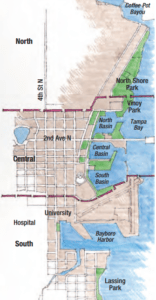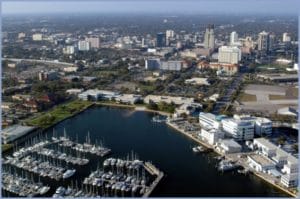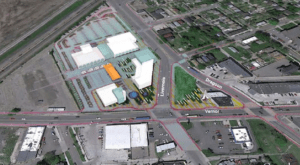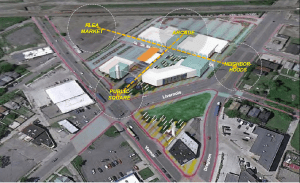Top Story
The Advisory Services Times-Dispatch is the on-line newsletter for ULI’s premier outreach program. Established in 1947, the Advisory Services program has conducted over 600 panels around the world.
This installment of our newsletter includes links to more information about the last few panels completed by ULI Advisory Services; a summary and update of the $800,000 Kresge Grant for the Institute’s resiliency program, and an overview of two recently completed panels – St. Petersburg, and Detroit, a list of upcoming panels this Spring and a spotlight on Hon. Glenda E. Hood, the 2013 Robert O’Donnell Award winner.
As always, I look forward to your feedback.
Thanks,
Tom Eitler, Vice President
ULI Advisory Services
Spotlight: Hon. Glenda E. Hood, 2013 Robert O’Donnell Award
 The Honorable Glenda E Hood is the recipient of the 2013 Robert O’Donnell Award. This annual award serves as an ongoing remembrance of Bob O’Donnell, a stalwart contributor to the success of ULI; acknowledges the time, effort and commitment that a particular ULI member has given to the Advisory Services Program; and enhances the importance of Advisory Services as an outreach program of the Institute.
The Honorable Glenda E Hood is the recipient of the 2013 Robert O’Donnell Award. This annual award serves as an ongoing remembrance of Bob O’Donnell, a stalwart contributor to the success of ULI; acknowledges the time, effort and commitment that a particular ULI member has given to the Advisory Services Program; and enhances the importance of Advisory Services as an outreach program of the Institute.
Mayor Hood was elected three-term Mayor of Orlando from 1992-2003 and then served as Florida Secretary of State from 2003-2005. Before being elected Orlando’s first woman mayor, she served as a City Council member for three terms from 1982-1992. She also owned her own public relations business.
Referred to as a “tireless visionary” with “marketing savvy,” and “tenacity and experience” by the Orlando Sentinel, Mayor Hood was known as a ‘hands-on’ leader and ardent advocate of growth management strategies and smart growth principles. Under her leadership, the city’s geographic area grew by 50%; older and historic in-town neighborhoods were revitalized; compatible new land-use infill was constructed; the city’s largest parks initiative built new parks and refurbished existing ones; unprecedented partnerships in education were established; regional transportation alternatives were championed; Orlando became positioned as a high-tech center and competitive international market; and the arts were elevated to a civic priority and economic driver.
In addition to her outstanding work with Advisory Services, Mayor Hood serves on the Rose Center for Public Leadership Advisory Board.
When not volunteering with ULI, she works as a co-founder and principle with triSect, a strategy consulting firm focused on civic innovation, serving the business, government and independent sectors.
ULI Receives $800,000 Grant from the Kresge Foundation to Support Institute’s Community Resiliency Program
In December 2013, ULI was awarded $800,000 from the Kresge Foundation to support the ULI’s community resiliency program which explores urban design and development practices that are more resilient and adaptable to the impact of climate change. This follows a July 2013 Advisory Services panel of the nation’s foremost authorities on real estate and urban planning who evaluated local and federal plans for strengthening resiliency in the Northeast communities affected by Hurricane Sandy, and brought guidance on rebuilding efforts in those areas.
As part of the integrated program of work, which will be done in 2014 and 2015, Advisory Services will be conducting panels in six communities, each of which will be chosen based on 1) the community’s long-range resilience challenges and vulnerabilities to weather and sea-level changes, and 2) the opportunity for the results to be applied to other communities with similar vulnerabilities. For more details, please contact: Tom Eitler, Vice President of Advisory Services.
Panel in focus: St. Petersburg, FL
Forging Connections for a Vibrant Downtown Waterfront
In September, the City of St. Petersburg, Florida, invited ULI to evaluate the downtown waterfront and identify its competitive advantage in the context of the adjacent downtown area and the Tampa–St. Petersburg region. More specifically, the panel spent time with the complete array of downtown waterfront assets, ranging from open space to facilities such as Al Lang Field and Albert Whitted Airport, to determine how they contribute to the long-term benefit of the waterfront, St. Petersburg’s residents, and visitors.
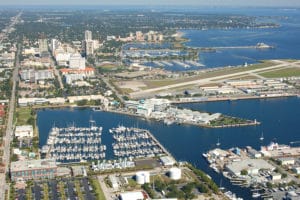
The St. Petersburg downtown waterfront
The panel’s effort involved evaluating the following issues, among others: how the waterfront affects downtown development, what urban design concepts can benefit the waterfront’s development, what transportation links are needed, and what potential economic opportunities emanate from the waterfront. The panel was chaired by Mike Higbee, Managing Director of DC Development Group.
Located on a peninsula in Pinellas County, with the Gulf of Mexico to the west and Tampa Bay to the east, the city of St. Petersburg—known to locals as “St. Pete”—is Florida’s fourth-largest city and the Tampa Bay region’s second largest. The population of the Tampa Bay Metropolitan Statistical Area (MSA) is 2.8 million, with St. Petersburg comprising 247,000. St. Petersburg’s high quality of life has allowed it to evolve from a retirement and tourist town to a diverse, economically vibrant community.
The panel’s study area was a generally continuous seven-mile public waterfront— a unique asset that has remained mostly untouched by private development since its establishment in the early 1900s. The large study area was broken down into North, Central, and South sections for analysis.
Despite the fact that the city is host to an abundance of facilities for recreation, entertainment and culture, tourism, and health and education, the panel likened these amenities to “pearls without a necklace.” The panel identified the South’s “Innovation District” as having the greatest unrealized potential for diversification due to the hospitals, university, and research activities in this area that provide a young, educated, job base to complement the intrinsic value of the downtown waterfront. The panel strongly agreed that a link from the downtown economic engine to the downtown waterfront is essential for both to prosper.
Among the panel recommendations were:
- Add a fixed-transit system to better link with larger transit and light-rail plans in the region
- Create better street frontages with human-scale interface
- Expand public art and add museums to the downtown waterfront
- Reduce parking space for public use and program events to include other sites beyond the waterfront
- Support bike share programs and improve bike parking and lanes
- Create a convertible street on the waterfront edge to enhance walking and biking
- Build a moveable bridge for active use along the waterfront
In order to strike the balance of linking the downtown economic engine to the downtown waterfront, the panel emphasized that special attention should be given to coordinating transit, event planning, management, and maintenance between private investment and support services downtown.
To coordinate and execute such tasks, five key delivery organizations were recommended, including:
- Division of Urban Planning and Historic Preservation
- Downtown Development Corporation,
- Chamber of Commerce,
- Downtown Business Improvement District (BID), and
- Waterfront Parks Conservancy.
The panel’s presentation and final report can be viewed here.
Panel in focus: Detroit, Michigan
In October 2013, the Southwest Detroit Business Association asked ULI to provide strategic land use recommendations for a 6.9 acre parcel located at West Vernor & Livernois Avenue. The panel was chaired by Leigh Ferguson, Director of Economic Development of the Downtown Development District of New Orleans, LA.
Southwest Detroit has long been a home to immigrants, first from Ireland, then Poland, Lebanon, Italy, and the U.S. South. More recently, immigrants have come from Mexico and other Latin American countries. Currently, the neighborhood’s population is about 50 percent Hispanic and almost half of the business community is Hispanic as well, with Middle Eastern merchants comprising another 40 percent. Southwest is widely known for its Hispanic restaurants, bakeries, grocers, and specialty food processing. Other enterprises involve producing and selling clothing and other goods for Hispanic celebrations, ornamental wrought iron manufacturing, and auto modifications such as for low riders. Southwest Detroit has remained stable and densely populated over the years.
The spine of the business district is the West Vernor corridor, which runs east/west through the community. In the center of the West Vernor business corridor is the subject of this study, a 6.9-acre land parcel with an abandoned streetcar and city vehicle repair facility. The site, currently owned by the Detroit Public Works (DPW), is blighted and hazardous, but has a number of geographic advantages that could be leveraged for its potential redevelopment.
The site is strategically located between the relatively successful West Vernor Avenue retail corridor and the industrial parcels adjacent to the CSX inter-modal rail facility. The panel was asked a series of land use, market and development potential questions including: Identify potential reuses and tenant mix for this site given the current and future trends market conditions in Southwest Detroit.
Based on market analysis, the panel found that while the area businesses meet and exceed food demand for the immediate market, the market is under-served in soft and hard good retail.
The analysis found that there is a $100 million gap between retail demand and current retail sales, which represents and important retail opportunity.
Based on the assignment, the panel has made a series of recommendations that are summarized here:
Based on its analysis of the site’s size constraints and advantages, design issues, the strength of the local market, and overall feasibility analysis, the panel has proposed a mixed-use development of 60,000 square feet for the DPW site.
- Development focus should be on creating a gathering place for residents and others that capitalizes uniqueness of community.
- To respond to market demand, the development should accommodate 25,500 to 53,000 square feet of retail space; 10,000 to 15,000 square feet of dining and food-related retailers; 5,000 to 10,000 square feet of incubator space for local artisans; and 10,000 to 20,000 square feet for food production.
- Onsite parking can be provided at a ratio of four spaces per 1,000 square feet of development.
- The central area should be developed as a public space, akin to a town plaza concept with seating, fountains, an amphitheater, and landscaping. Bridge the gap on West Vernor from the east to west, connecting the link through the railway underpass. Implement streetscape improvements to strengthen pedestrian access and visual continuity.
- Involve the local community and its leadership, including SDBA as a major stakeholder who will facilitate strategic partnerships with the Detroit Economic Growth Corporation (DEGC), Eastern Market Corporation, and other organizations.
- Be able to move quickly, remembering the old real estate adage that “time kills all deals.”
- Create a replicable process and project, to serve as a model for other community development projects around the city, particularly those dealing with blighted, surplus properties of the city.
The panel’s presentations can be viewed here.
The full Detroit Panel Report will be released in early 2014.
Coming Up:
ULI Advisory Services will soon visit the following locations:
- Seattle, Washington
- Atlantic City, New Jersey
- Raleigh-Durham Airport, North Carolina
- North End – Charlotte, North Carolina
ULI Advisory Services recently completed panels in the following locations:
- Sanya, China
- Nashville, Tennessee
- St. Petersburg, Florida
- Long Boat Key, Florida
- Pasco County, Florida
- Detroit, Michigan
- Tucson, Arizona
